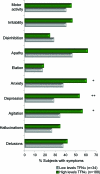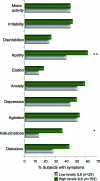Proinflammatory cytokines, sickness behavior, and Alzheimer disease
- PMID: 21753171
- PMCID: PMC3136056
- DOI: 10.1212/WNL.0b013e318225ae07
Proinflammatory cytokines, sickness behavior, and Alzheimer disease
Abstract
Background: In Alzheimer disease (AD), systemic inflammation is known to give rise to a delirium. However, systemic inflammation also gives rise to other centrally mediated symptoms in the absence of a delirium, a concept known as sickness behavior. Systemic inflammation is characterized by the systemic production of the proinflammatory cytokines tumor necrosis factor-α (TNFα) and interleukin-6 (IL-6) that mediate immune to brain communication and the development of sickness behavior.
Objective: To determine if raised serum TNFα or IL-6 are associated with the presence of sickness behavior symptoms, independent of the development of delirium, in a prospective cohort study of subjects with AD.
Methods: A total of 300 subjects with mild to severe AD were cognitively assessed at baseline and a blood sample taken for inflammatory markers. Cognitive assessments, including assessments to detect the development of a delirium, and blood samples were repeated at 2, 4, and 6 months. The development of neuropsychiatric symptoms in the subject with AD over the 6-month follow-up period was assessed independently by carer interview at 2, 4, and 6 months.
Results: Raised serum TNFα and IL-6, but not CRP, were associated with an approximately 2-fold increased frequency of neuropsychiatric symptoms characteristic of sickness behavior. These relationships are independent of the development of delirium.
Conclusions: Increased serum proinflammatory cytokines are associated with the presence of symptoms characteristic of sickness behavior, which are common neuropsychiatric features found in AD. This association was independent of the presence of delirium.
Figures


Comment in
-
Risk factors for Alzheimer disease: aging beyond age?Neurology. 2011 Jul 19;77(3):206-7. doi: 10.1212/WNL.0b013e31822550af. Epub 2011 Jul 13. Neurology. 2011. PMID: 21753168 No abstract available.
Similar articles
-
Biomarkers of vascular risk, systemic inflammation, and microvascular pathology and neuropsychiatric symptoms in Alzheimer's disease.J Alzheimers Dis. 2013;35(2):363-71. doi: 10.3233/JAD-122359. J Alzheimers Dis. 2013. PMID: 23403534 Free PMC article.
-
Cytokines: how important are they in mediating sickness?Neurosci Biobehav Rev. 2013 Jan;37(1):1-10. doi: 10.1016/j.neubiorev.2012.11.001. Epub 2012 Nov 12. Neurosci Biobehav Rev. 2013. PMID: 23153795 Review.
-
Emotional acceptance, inflammation, and sickness symptoms across the first two years following breast cancer diagnosis.Brain Behav Immun. 2016 Aug;56:165-74. doi: 10.1016/j.bbi.2016.02.018. Epub 2016 Feb 23. Brain Behav Immun. 2016. PMID: 26916219 Free PMC article.
-
At the extreme end of the psychoneuroimmunological spectrum: delirium as a maladaptive sickness behaviour response.Brain Behav Immun. 2013 Feb;28:1-13. doi: 10.1016/j.bbi.2012.07.012. Epub 2012 Aug 3. Brain Behav Immun. 2013. PMID: 22884900 Free PMC article. Review.
-
Systemic inflammation and disease progression in Alzheimer disease.Neurology. 2009 Sep 8;73(10):768-74. doi: 10.1212/WNL.0b013e3181b6bb95. Neurology. 2009. PMID: 19738171 Free PMC article.
Cited by
-
Systemic TNF-α produces acute cognitive dysfunction and exaggerated sickness behavior when superimposed upon progressive neurodegeneration.Brain Behav Immun. 2017 Jan;59:233-244. doi: 10.1016/j.bbi.2016.09.011. Epub 2016 Sep 12. Brain Behav Immun. 2017. PMID: 27633985 Free PMC article.
-
The cellular model for Alzheimer's disease research: PC12 cells.Front Mol Neurosci. 2023 Jan 4;15:1016559. doi: 10.3389/fnmol.2022.1016559. eCollection 2022. Front Mol Neurosci. 2023. PMID: 36683856 Free PMC article.
-
Effects of Tea Catechins on Alzheimer's Disease: Recent Updates and Perspectives.Molecules. 2018 Sep 14;23(9):2357. doi: 10.3390/molecules23092357. Molecules. 2018. PMID: 30223480 Free PMC article. Review.
-
A peripheral neutrophil-related inflammatory factor predicts a decline in executive function in mild Alzheimer's disease.J Neuroinflammation. 2020 Mar 14;17(1):84. doi: 10.1186/s12974-020-01750-3. J Neuroinflammation. 2020. PMID: 32171317 Free PMC article.
-
Interaction between C-reactive protein and cognitive functions according to APOE gene polymorphism in post-menopausal women.Arch Med Sci. 2016 Dec 1;12(6):1247-1255. doi: 10.5114/aoms.2016.62868. Epub 2016 Oct 24. Arch Med Sci. 2016. PMID: 27904515 Free PMC article.
References
MeSH terms
Substances
Grants and funding
LinkOut - more resources
Full Text Sources
Other Literature Sources
Medical
Research Materials
Miscellaneous
